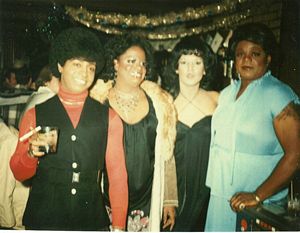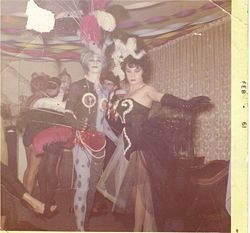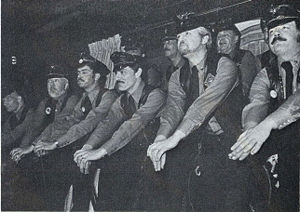WisLGBT Sidebar: Taking Pride in Stereotypes
Wisconsin LGBT History SIDEBAR
Taking Pride in Stereotypes: Drag Queens, Butch Dykes and Leathermen
Source: from an article by Don Schwamb, appearing in the June, 2006 issue of the Q-Life Newspaper.
Over the years gay and lesbian people have become more accepted by society as a whole. As that has happened, some of the stereotypical forms of dress and behavior — drag shows and performers, leathermen and gay clones, butch lesbians — seem to have become less common. I see less of all of them than I did even 10 years ago. These forms of dress and behavior make a statement in today’s LGBT culture, but the statement has changed.
And these stereotypes make us more visible to the mainstream community — which is both good and bad. To many of us, it’s bad because we are uncomfortable being associated with a stereotype that doesn’t fit us and maybe even embarrasses us.
But the good in these stereotypical behaviors is much stronger than any harm. They put a unique face on the gay and lesbian community and reveal us as a subset of the culture. Whether we, individually, relate to going in drag, we have to give credit to those men who do for having the balls to be that “in your face” and push back against ignorance to advance all of our rights. Let’s not forget that the Stonewall riot was started largely by drag queens who were fed up with being pushed around.
Likewise, leathermen, the gay clone, and the butch dyke are all obvious symbols of our differences and an expression of our individual selves, proof that we need not conform to be a productive part of a whole.
So what are the types, and what has changed?
Drag Shows and Divas
Drag shows and men who go out in drag are perhaps not as commonplace in LGBT bars today as they were 10 or 20 years ago. Although there are still occasional drag shows at some of the clubs, they have become the exception rather than the rule. Twenty years ago, it seemed every non-leather bar had drag shows regularly; today I can think of only a handful that do.
And even then there are degrees of drag: The last show at the M&M Club reminded me of how some men dress up as nuns or other characters as a fun diversion for the occasional show (Baby Jane Hudson is another example), while others do it more frequently, perhaps for a weekly drag show or for the pageants or “Miss” contests held throughout the year. And a few men dress up in drag just for a night on the town.
Leathermen and the Gay Clone
We all recognize the uniform of the leatherman — plenty of black leather with silver studs: a vest with no shirt or a (usually white) T-shirt; black leather chaps over faded blue jeans; black boots; a cockily worn black leather hat. This was also the primary vehicle for the hankie code (the color and position of a hankie in a back pocket signaled whether you were a top or bottom and what you were generally “into” sexually). While sometimes identified with the motorcycle (and thus the genesis of biker groups), the gear is readily found in any “Levi-leather” men’s bar. A close relative of this look is, of course, the uniform look — sometimes military, but more often the police look.
The gay clone look is not as common today as it was in the late ’80s and early ’90s. That look was a tight, unlabeled T-shirt or polo shirt, snug blue jeans, dark shoes or boots, and often a mustache. Sometimes the hankie code was incorporated. The mustache is now passé and the T-shirt has given way to looser shirts of all types, but otherwise the gay clone uniform is much the same. Khaki slacks were always an option, and today tennies and sandals are more common. Perhaps this is a sign of our blending more with the rest of society. Still, many of us can pick out a gay man in any setting, partly, I think, because of this gay clone look (some of us call that gay-dar).
Butch Dykes
The butch dyke — and this is not meant as a slam, just as drag queen is not meant as one — is the lesbian who drives a pickup truck, has hair much shorter than the norm for a woman, wears slacks or shorts but never a dress, etc. In my admittedly limited observation, I see less of this today than I did years ago, also. Some still go to the extreme, and it’s still uncommon to see a lesbian in a dress at an LGBT gathering, but the butch has become less extreme.
Conclusion
I think the gradual acceptance of gay and lesbian people into general society has lessened the need to make ourselves stand out to make a statement. We are more comfortable with who we are without being “in your face” about our differences. But let’s not forget how we got where we are now. Let’s embrace and enjoy the occasional drag show, leather event etc. Let’s have pride in our evolution and recognize that these stereotypical extremes contributed to mainstream society’s increased acceptance of us.
- Return to PEOPLE page: Wis. LGBT History-- People
- Return to INTRO page: Wisconsin LGBT History Project- Intro
Explore the full web site documenting GLBT life in Milwaukee, Madison, Green Bay, and all of Wisconsin at: http://www.WisconsinGayHistory.org
Source: 1960s-1970s color photos courtesy of Josie Carter. All other contents from an article by Don Schwamb, appearing in the June, 2006 issue of the Q-Life Newspaper.


